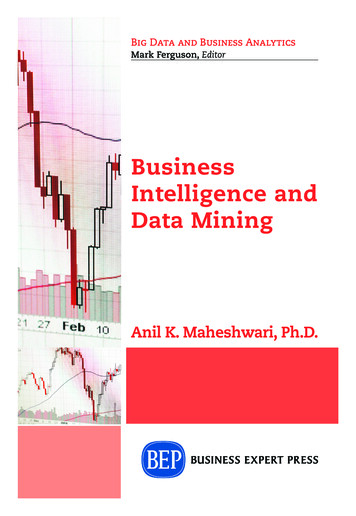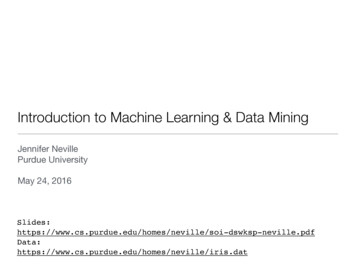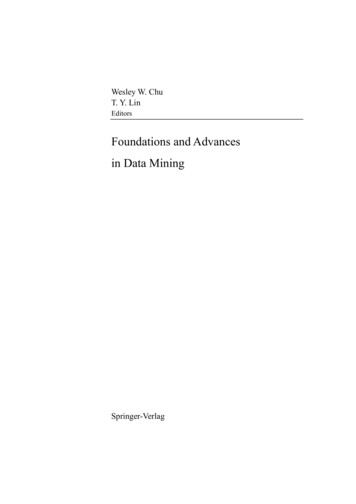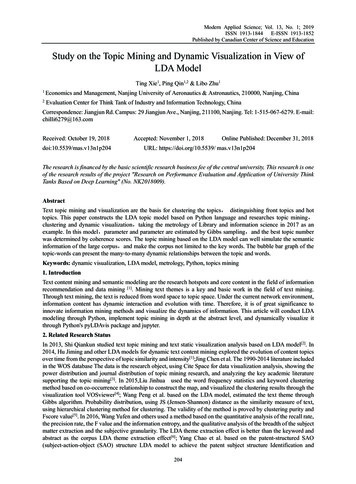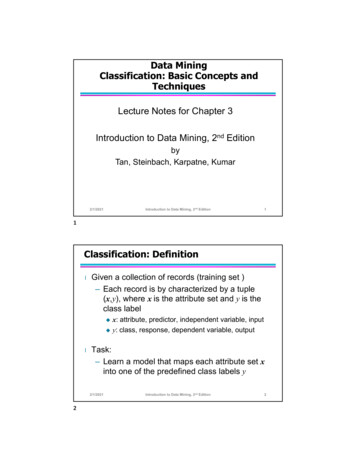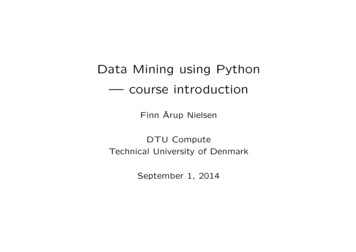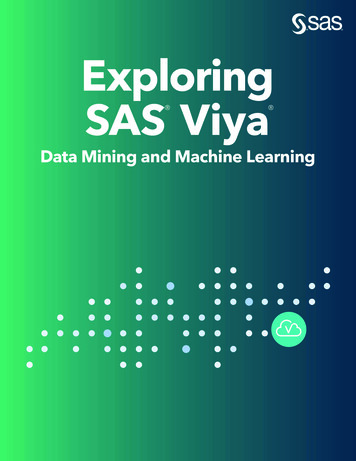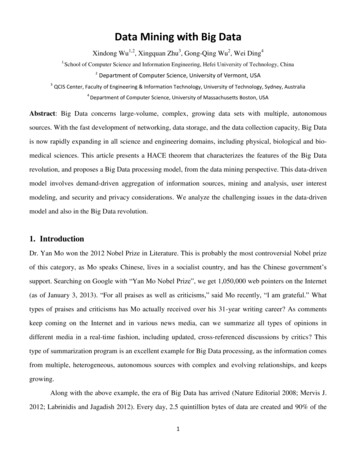
Transcription
Data Mining with Big DataXindong Wu1,2, Xingquan Zhu3, Gong-Qing Wu2, Wei Ding41School of Computer Science and Information Engineering, Hefei University of Technology, China23Department of Computer Science, University of Vermont, USAQCIS Center, Faculty of Engineering & Information Technology, University of Technology, Sydney, Australia4Department of Computer Science, University of Massachusetts Boston, USAAbstract: Big Data concerns large-volume, complex, growing data sets with multiple, autonomoussources. With the fast development of networking, data storage, and the data collection capacity, Big Datais now rapidly expanding in all science and engineering domains, including physical, biological and biomedical sciences. This article presents a HACE theorem that characterizes the features of the Big Datarevolution, and proposes a Big Data processing model, from the data mining perspective. This data-drivenmodel involves demand-driven aggregation of information sources, mining and analysis, user interestmodeling, and security and privacy considerations. We analyze the challenging issues in the data-drivenmodel and also in the Big Data revolution.1. IntroductionDr. Yan Mo won the 2012 Nobel Prize in Literature. This is probably the most controversial Nobel prizeof this category, as Mo speaks Chinese, lives in a socialist country, and has the Chinese government’ssupport. Searching on Google with “Yan Mo Nobel Prize”, we get 1,050,000 web pointers on the Internet(as of January 3, 2013). “For all praises as well as criticisms,” said Mo recently, “I am grateful.” Whattypes of praises and criticisms has Mo actually received over his 31-year writing career? As commentskeep coming on the Internet and in various news media, can we summarize all types of opinions indifferent media in a real-time fashion, including updated, cross-referenced discussions by critics? Thistype of summarization program is an excellent example for Big Data processing, as the information comesfrom multiple, heterogeneous, autonomous sources with complex and evolving relationships, and keepsgrowing.Along with the above example, the era of Big Data has arrived (Nature Editorial 2008; Mervis J.2012; Labrinidis and Jagadish 2012). Every day, 2.5 quintillion bytes of data are created and 90% of the1
data in the world today were produced within the past two years (IBM 2012). Our capability for datageneration has never been so powerful and enormous ever since the invention of the InformationTechnology in the early 19th century. As another example, on October 4, 2012, the first presidentialdebate between President Barack Obama and Governor Mitt Romney triggered more than 10 milliontweets within two hours (Twitter Blog 2012). Among all these tweets, the specific moments thatgenerated the most discussions actually revealed the public interests, such as the discussions aboutMedicare and vouchers. Such online discussions provide a new means to sense the public interests andgenerate feedback in real-time, and are mostly appealing compared to generic media, such as radio or TVbroadcasting. Another example is Flickr, a public picture sharing site, which received 1.8 million photosper day, on average, from February to March 2012 (Michel F. 2012). Assuming the size of each photo is 2megabytes (MB), this resulted in 3.6 terabytes (TB) storage every single day. As “a picture is worth athousand words”, the billions of pictures on Flicker are a treasure tank for us to explore the human society,social events, public affairs, disasters etc., only if we have the power to harness the enormous amount ofdata.The above examples demonstrate the rise of Big Data applications where data collection has growntremendously and is beyond the ability of commonly used software tools to capture, manage, and processwithin a “tolerable elapsed time”. The most fundamental challenge for the Big Data applications is toexplore the large volumes of data and extract useful information or knowledge for future actions(Rajaraman and Ullman, 2011). In many situations, the knowledge extraction process has to be veryefficient and close to real-time because storing all observed data is nearly infeasible. For example, theSquare Kilometer Array (SKA) (Dewdney et al. 2009) in Radio Astronomy consists of 1,000 to 1,500 15meter dishes in a central 5km area. It provides 100 times more sensitive vision than any existing theUniverse.However,witha40gigabytes(GB)/second data volume, the data generated from the SKA is exceptionally large. Althoughresearchers have confirmed that interesting patterns, such as transient radio anomalies (Reed et al. 2011)can be discovered from the SKA data, existing methods are incapable of handling this Big Data. As aresult, the unprecedented data volumes require an effective data analysis and prediction platform toachieve fast-response and real-time classification for such Big Data.2
The remainder of the paper is structured as follows. In Section 2, we propose a HACE theorem tomodel Big Data characteristics. Section 3 summarizes the key challenges for Big Data mining. Some keyresearch initiatives and the authors’ national research projects in this field are outlined in Section 4.Related work is discussed in Section 5, and we conclude the paper in Section 6.Figure 1: The blind men and the giant elephant: the localized (limited) view of each blind man leads to a biased conclusion.2. Big Data Characteristics: HACE TheoremHACE Theorem: Big Data starts with large-volume, heterogeneous, autonomous sources withdistributed and decentralized control, and seeks to explore complex and evolving relationships amongdata.These characteristics make it an extreme challenge for discovering useful knowledge from the BigData. In a naïve sense, we can imagine that a number of blind men are trying to size up a giant elephant(see Figure 1), which will be the Big Data in this context. The goal of each blind man is to draw a picture(or conclusion) of the elephant according to the part of information he collected during the process.Because each person’s view is limited to his local region, it is not surprising that the blind men will eachconclude independently that the elephant “feels” like a rope, a hose, or a wall, depending on the regioneach of them is limited to. To make the problem even more complicated, let’s assume that (a) the elephantis growing rapidly and its pose also changes constantly, and (b) the blind men also learn from each otherwhile exchanging information on their respective feelings on the elephant. Exploring the Big Data in this3
scenario is equivalent to aggregating heterogeneous information from different sources (blind men) tohelp draw a best possible picture to reveal the genuine gesture of the elephant in a real-time fashion.Indeed, this task is not as simple as asking each blind man to describe his feelings about the elephant andthen getting an expert to draw one single picture with a combined view, concerning that each individualmay speak a different language (heterogeneous and diverse information sources) and they may even haveprivacy concerns about the messages they deliberate in the information exchange process.2.1 Huge Data with Heterogeneous and Diverse DimensionalityOne of the fundamental characteristics of the Big Data is the huge volume of data represented byheterogeneous and diverse dimensionalities. This is because different information collectors use their ownschemata for data recording, and the nature of different applications also results in diverse representationsof the data. For example, each single human being in a bio-medical world can be represented by usingsimple demographic information such as gender, age, family disease history etc. For X-ray examinationand CT scan of each individual, images or videos are used to represent the results because they providevisual information for doctors to carry detailed examinations. For a DNA or genomic related test,microarray expression images and sequences are used to represent the genetic code information becausethis is the way that our current techniques acquire the data. Under such circumstances, the heterogeneousfeatures refer to the different types of representations for the same individuals, and the diverse featuresrefer to the variety of the features involved to represent each single observation. Imagine that differentorganizations (or health practitioners) may have their own schemata to represent each patient, the dataheterogeneity and diverse dimensionality issues become major challenges if we are trying to enable dataaggregation by combining data from all sources.2.2 Autonomous Sources with Distributed and Decentralized ControlAutonomous data sources with distributed and decentralized controls are a main characteristic of Big Dataapplications. Being autonomous, each data sources is able to generate and collect information withoutinvolving (or relying on) any centralized control. This is similar to the World Wide Web (WWW) settingwhere each web server provides a certain amount of information and each server is able to fully function4
without necessarily relying on other servers. On the other hand, the enormous volumes of the data alsomake an application vulnerable to attacks or malfunctions, if the whole system has to rely on anycentralized control unit. For major Big Data related applications, such as Google, Flicker, Facebook, andWalmart, a large number of server farms are deployed all over the world to ensure nonstop services andquick responses for local markets. Such autonomous sources are not only the solutions of the technicaldesigns, but also the results of the legislation and the regulation rules in different countries/regions. Forexample, Asian markets of Walmart are inherently different from its North American markets in terms ofseasonal promotions, top sell items, and customer behaviors. More specifically, the local governmentregulations also impact on the wholesale management process and eventually result in datarepresentations and data warehouses for local markets.2.3 Complex and Evolving RelationshipsWhile the volume of the Big Data increases, so do the complexity and the relationships underneath thedata. In an early stage of data centralized information systems, the focus is on finding best feature valuesto represent each observation. This is similar to using a number of data fields, such as age, gender, income,education background etc., to characterize each individual. This type of sample-feature representationinherently treats each individual as an independent entity without considering their social connectionswhich is one of the most important factors of the human society. People form friend circles based on theircommon hobbies or connections by biological relationships. Such social connections commonly exist innot only our daily activities, but also are very popular in virtual worlds. For example, major socialnetwork sites, such as Facebook or Twitter, are mainly characterized by social functions such as friendconnections and followers (in Twitter). The correlations between individuals inherently complicate thewhole data representation and any reasoning process. In the sample-feature representation, individuals areregarded similar if they share similar feature values, whereas in the sample-feature-relationshiprepresentation, two individuals can be linked together (through their social connections) even though theymight share nothing in common in the feature domains at all. In a dynamic world, the features used torepresent the individuals and the social ties used to represent our connections may also evolve withrespect to temporal, spatial, and other factors. Such a complication is becoming part of the reality for Big5
Data applications, where the key is to take the complex (non-linear, many-to-many) data relationships,along with the evolving changes, into consideration, to discover useful patterns from Big Data collections.Figure 2: A Big Data processing framework: The research challenges form a three tier structure andcenter around the “Big Data mining platform” (Tier I), which focuses on low-level data accessing andcomputing. Challenges on information sharing and privacy, and Big Data application domains andknowledge form Tier II, which concentrates on high level semantics, application domain knowledge,and user privacy issues. The outmost circle shows Tier III challenges on actual mining algorithms.3. Data Mining Challenges with Big DataFor an intelligent learning database system (Wu 2000) to handle Big Data, the essential key is to scale upto the exceptionally large volume of data and provide treatments for the characteristics featured by theaforementioned HACE theorem. Figure 2 shows a conceptual view of the Big Data processing framework,which includes three tiers from inside out with considerations on data accessing and computing (Tier I),data privacy and domain knowledge (Tier II), and Big Data mining algorithms (Tier III).The challenges at Tier I focus on data accessing and actual computing procedures. Because Big Dataare often stored at different locations and data volumes may continuously grow, an effective computingplatform will have to take distributed large-scale data storage into consideration for computing. For6
example, while typical data mining algorithms require all data to be loaded into the main memory, this isbecoming a clear technical barrier for Big Data because moving data across different locations isexpensive (e.g., subject to intensive network communication and other IO costs), even if we do have asuper large main memory to hold all data for computing.The challenges at Tier II center around semantics and domain knowledge for different Big Dataapplications. Such information can provide additional benefits to the mining process, as well as addtechnical barriers to the Big Data access (Tier I) and mining algorithms (Tier III). For example, dependingon different domain applications, the data privacy and information sharing mechanisms between dataproducers and data consumers can be significantly different. Sharing sensor network data for applicationslike water quality monitoring may not be discouraged, whereas releasing and sharing mobile users’location information is clearly not acceptable for majority, if not all, applications. In addition to the aboveprivacy issues, the application domains can also provide additional information to benefit or guide BigData mining algorithm designs. For example, in market basket transactions data, each transaction isconsidered independent and the discovered knowledge is typically represented by finding highlycorrelated items, possibly with respect to different temporal and/or spatial restrictions. In a social network,on the other hand, users are linked and share dependency structures. The knowledge is then representedby user communities, leaders in each group, and social influence modeling etc. Therefore, understandingsemantics and application knowledge is important for both low-level data access and for high levelmining algorithm designs.At Tier III, the data mining challenges concentrate on algorithm designs in tackling the difficultiesraised by the Big Data volumes, distributed data distributions, and by complex and dynamic datacharacteristics. The circle at Tier III contains three stages. Firstly, sparse, heterogeneous, uncertain,incomplete, and multi-source data are preprocessed by data fusion techniques. Secondly, complex anddynamic data are mined after pre-processing. Thirdly, the global knowledge that is obtained by locallearning and model fusion is tested and relevant information is fed back to the pre-processing stage. Thenthe model and parameters are adjusted according to the feedback. In the whole process, informationsharing is not only a promise of smooth development of each stage, but also a purpose of Big Dataprocessing.7
In the following, we elaborate challenges with respect the three tier framework in Figure 2.3.1 Tier I: Big Data Mining PlatformIn typical data mining systems, the mining procedures require computational intensive computing unitsfor data analysis and comparisons. A computing platform is therefore needed to have efficient access to,at least, two types of resources: data and computing processors. For small scale data mining tasks, asingle desktop computer, which contains hard disk and CPU processors, is sufficient to fulfill the datamining goals. Indeed, many data mining algorithm are designed to handle this type of problem settings.For medium scale data mining tasks, data are typically large (and possibly distributed) and cannot be fitinto the main memory. Common solutions are to rely on parallel computing (Shafer et al. 1996; Luo et al.2012) or collective mining (Chen et al. 2004) to sample and aggregate data from different sources andthen use parallel computing programming (such as the Message Passing Interface) to carry out the miningprocess.For Big Data mining, because data scale is far beyond the capacity that a single personal computer(PC) can handle, a typical Big Data processing framework will rely on cluster computers with a highperformance computing platform, where a data mining task is deployed by running some parallelprogramming tools, such as MapReduce or ECL (Enterprise Control Language), on a large number ofcomputing nodes (i.e., clusters). The role of the software component is to make sure that a single datamining task, such as finding the best match of a query from a database with billions of samples, is splitinto many small tasks each of which is running on one or multiple computing nodes. For example, as ofthis writing, the world most powerful super computer Titan, which is deployed at Oak Ridge NationalLaboratory in Tennessee, USA, contains 18,688 nodes each with a 16-core CPU.Such a Big Data system, which blends both hardware and software components, is hardly availablewithout key industrial stockholders’ support. In fact, for decades, companies have been making businessdecisions based on transactional data stored in relational databases. Big Data mining offers opportunitiesto go beyond their relational databases to rely on less structured data: weblogs, social media, email,sensors, and photographs that can be mined for useful information. Major business intelligence companies,such IBM, Oracle, Teradata etc., have all featured their own products to help customers acquire and8
organize these diverse data sources and coordinate with customers’ existing data to find new insights andcapitalize on hidden relationships.3.2 Tier II: Big Data Semantics and Application KnowledgeSemantics and application knowledge in Big Data refer to numerous aspects related to the regulations,policies, user knowledge, and domain information. The two most important issues at this tier include (1)data sharing and privacy; and (2) domain and application knowledge. The former provides answers toresolve concerns on how data are maintained, accessed, and shared; whereas the latter focuses onanswering questions like “what are the underlying applications ?” and “what are the knowledge orpatterns users intend to discover from the data ?”.3.2.1Information Sharing and Data PrivacyInformation sharing is an ultimate goal for all systems involving multiple parties (Howe et al. 2008).While the motivation for sharing is clear, a real-world concern is that Big Data applications are related tosensitive information, such as banking transactions and medical records, and so simple data exchanges ortransmissions do not resolve privacy concerns (Duncan 2007, Huberman 2012,Schadt 2012). Forexample, knowing people’s locations and their preferences, one can enable a variety of useful locationbased services, but public disclosure of an individual’s movements over time can have seriousconsequences for privacy. To protect privacy, two common approaches are to (1) restrict access to thedata, such as adding certification or access control to the data entries, so sensitive information isaccessible by a limited group of users only, and (2) anonymize data fields such that sensitive informationcannot be pinpointed to an individual record (Cormode and Srivastava 2009). For the first approach,common challenges are to design secured certification or access control mechanisms, such that nosensitive information can be misconducted by unauthorized individuals. For data anonymization, the mainobjective is to inject randomness into the data to ensure a number of privacy goals. For example, the mostcommon k-anonymity privacy measure is to ensure that each individual in the database must beindistinguishable from k 1 others. Common anonymization approaches are to use suppression,generalization, perturbation, and permutation to generate an altered version of the data, which is, in fact,some uncertain data.9
One of the major benefits of the data annomization based information sharing approaches is that, onceanonymized, data can be freely shared across different parties without involving restrict access controls.This naturally leads to another research area namely privacy preserving data mining (Lindell and Pinkas2000), where multiple parties, each holding some sensitive data, are trying to achieve a data mining goalwithout sharing any sensitive information inside the data. This privacy preserving mining goal, in practice,can be solved through two types of approaches including (1) using some communication protocols, suchas Yao’s protocol (Yao 1986), to request the distributions of the whole dataset, rather than requesting theactual values of each record, or (2) to design some special data mining methods to derive knowledge fromanonymized data (this is inherently similar to the uncertain data mining methods).3.2.2 Domain and Application KnowledgeDomain and application knowledge (Kopanas et al. 2002) provides essential information for designingBig Data mining algorithms and systems. In a simple case, domain knowledge can help identify rightfeatures for modeling the underlying data (e.g., blood glucose level is clearly a better feature than bodymass in diagnosing Type II diabetes). The domain and application knowledge can also help designachievable business objectives by using Big Data analytical techniques. For example, stock market dataare a typical domain which constantly generates a large quantity of information, such as bids, buys, andputs, in every single second. The market continuously evolves and is impacted by different factors, suchas domestic and international news, government reports, and natural disasters etc. An appealing Big Datamining task is to design a Big Data mining system to predict the movement of the market in the next oneor two minutes. Such systems, even if the prediction accuracy is just slightly better than random guess,will bring significant business values to the developers (Bughin et al. 2010). Without correct domainknowledge, it is a clear challenge to find effective matrices/measures to characterize the marketmovement, and such knowledge is often beyond the mind of the data miners, although some recentresearch has shown that using social networks, such as Twitter, it is possible to predict the stock marketupward/downward trends (Bollen et al. 2011) with good accuracies.10
3.3 Tier III: Big Data Mining Algorithms3.3.1 Local Learning and Model Fusion for Multiple Information SourcesAs Big Data applications are featured with autonomous sources and decentralized controls, aggregatingdistributed data sources to a centralized site for mining is systematically prohibitive due to the potentialtransmission cost and privacy concerns. On the other hand, although we can always carry out miningactivities at each distributed site, the biased view of the data collected at each different site often leads tobiased decisions or models, just like the elephant and blind men case. Under such a circumstance, a BigData mining system has to enable an information exchange and fusion mechanism to ensure that alldistributed sites (or information sources) can work together to achieve a global optimization goal. Modelmining and correlations are the key steps to ensure that models or patterns discovered from multipleinformation sources can be consolidated to meet the global mining objective. More specifically, the globalmining can be featured with a two-step (local mining and global correlation) process, at data, model, andat knowledge levels. At the data level, each local site can calculate the data statistics based on the localdata sources and exchange the statistics between sites to achieve a global data distribution view. At themodel or pattern level, each site can carry out local mining activities, with respect to the localized data, todiscover local patterns. By exchanging patterns between multiple sources, new global patterns can besynthetized by aggregating patterns across all sites (Wu and Zhang 2003). At the knowledge level, modelcorrelation analysis investigates the relevance between models generated from different data sources todetermine how relevant the data sources are correlated to each other, and how to form accurate decisionsbased on models built from autonomous sources.3.3.2Mining from Sparse, Uncertain, and Incomplete DataSpare, uncertain, and incomplete data are defining features for Big Data applications. Being sparse, thenumber of data points is too few for drawing reliable conclusions. This is normally a complication of thedata dimensionality issues, where data in a high dimensional space (such as more than 1000 dimensions)does not show clear trends or distributions. For most machine learning and data mining algorithms, highdimensional spare data significantly deteriorate the difficulty and the reliability of the models derivedfrom the data. Common approaches are to employ dimension reduction or feature selection (Wu et al.2012) to reduce the data dimensions or to carefully include additional samples to decrease the data11
scarcity, such as generic unsupervised learning methods in data mining.Uncertain data are a special type of data reality where each data field is no longer deterministic butis subject to some random/error distributions. This is mainly linked to domain specific applications withinaccurate data readings and collections. For example, data produced from GPS equipment is inherentlyuncertain, mainly because the technology barrier of the device limits the precision of the data to certainlevels (such as 1 meter). As a result, each recording location is represented by a mean value plus avariance to indicate expected errors. For data privacy related applications (Mitchell 2009), users mayintentionally inject randomness/errors into the data in order to remain anonymous. This is similar to thesituation that an individual may not feel comfortable to let you know his/her exact income, but will befine to provide a rough range like [120k, 160k]. For uncertain data, the major challenge is that each dataitem is represented as some sample distributions but not as a single value, so most existing data miningalgorithms cannot be directly applied. Common solutions are to take the data distributions intoconsideration to estimate model parameters. For example, error aware data mining (Wu and Zhu 2008)utilizes the mean and the variance values with respect to each single data item to build a Naïve Bayesmodel for classification. Similar approaches have also been applied for decision trees or database queries.Incomplete data refers to the missing of data field values for some samples. The missing values can becaused by different realities, such as the malfunction of a sensor node, or some systematic policies tointentionally skip some values (e.g., dropping some sensor node readings to save power for transmission).While most modern data mining algorithms have inbuilt solutions to handle missing values (such asignoring data fields with missing values), data imputation is an established research field which seeks toimpute missing values in order to produce improved models (compared to the ones built from the originaldata). Many imputation methods (Efron 1994) exist for this purpose, and the major approaches are to fillmost frequently observed values or to build learning models to predict possible values for each data field,based on the observed values of a given instance.3.3.3Mining Complex and Dynamic DataThe rise of Big Data is driven by the rapid increasing of complex data and their changes in volumes andin nature (Birney 2012). Documents posted on WWW servers, Internet backbones, social networks,communication networks, and transportation networks etc. are all featured with complex data. While12
complex dependency structures underneath the data raise the difficulty for our learning systems, they alsooffer exciting opportunities that simple data representations are incapable of achieving. For example,researchers have successfully used Twitter, a well-known social networking facility, to detect events suchas earthquakes and major social activities, with nearly online speed and very high accuracy. In addition,the knowledge of people’s queries to search engines also enables a new early warning system fordetecting fast spreading flu outbreaks (Helft 2008). Making use of complex data is a major challenge forBig Data applications, because any two parties in a complex network are potentially interested to eachother with a social connection. Such a connection is quadratic with respect to the number of nodes in thenetwork, so a million node network may be subject to one trillion connections. For a large social networksite, like Facebook, the number of active users has already reached 1 billion, and analyzing such anenormous network is a big challenge for Big Data mining. If we take daily user actions/interactions intoconsideration, the scale of difficu
2. Big Data Characteristics: HACE Theorem HACE Theorem: Big Data starts with large-volume, heterogeneous, autonomous sources with distributed and decentralized control, and seeks to explore complex and evolving relationships among data. These characteristics make it an extreme challenge for discove

